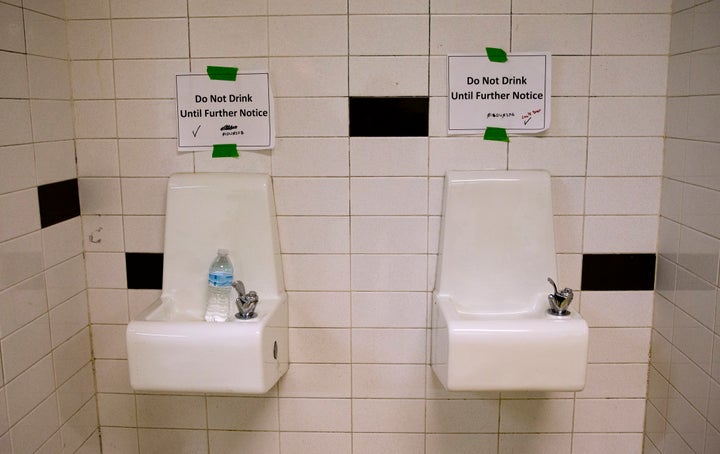
It may have started in Portland, where elevated levels of lead were found in the drinking water at two public elementary schools last month. High levels were later detected in more schools.
Schools in Chicago, Atlanta, D.C. and other school districts across the country have seen similar results from water testing in recent months.
With school out for summer and the ongoing Flint water crisis still looming on the minds of administrators and parents alike, many districts are moving to test their drinking water for signs of lead contamination. According to The Washington Post, at least one prominent testing firm is experiencing high demand and is already booked through the start of the school year.
Under current federal regulations, only 10 percent of schools nationwide ― those that rely on water supplies independent of any community utilities ― are actually required to test their water.
Some state lawmakers are moving to change that. In New York, the state legislature last month approved a bill that would be the nation’s first to mandate that public schools test their drinking water for lead. It is currently awaiting Gov. Andrew Cuomo’s signature. Similar legislation has also been proposed in North Carolina. And in May, New Jersey Gov. Chris Christie ordered mandatory lead-in-water testing at the state’s schools.
This is important progress in the fight against lead exposure, which can cause brain and nervous system damage, hearing issues, reduced IQ and a myriad of other issues, particularly in children. But there’s reason to remain skeptical, experts say.
One of those experts is Yanna Lambrinidou, a Virginia Tech researcher who has been studying water contamination for many years and in 2010 co-authored the paper “Failing Our Children: Lead In U.S. School Drinking Water” in the journal New Solutions.
The Huffington Post recently spoke with Lambrinidou about this summer’s surge in testing and what solutions there might be for the massive problem.
This interview has been edited for length and clarity.
How much of what is happening now with all this testing is being done to appease parents in the short term vs. working toward a viable long-term solution?
It’s hard to tell for sure. One thing that seems more clear to me is that we seem to be at a crossroads between two paradigms of thought about lead in drinking water. I think the paradigm we are in right now, and that we tend to be in as a nation, is the paradigm that was created by the EPA and by the Lead and Copper Rule that allowed for some lead to flow out of taps that people drank, while at the same time, schools and water utilities can claim that all is OK and that lead is a problem that’s under control.
That same paradigm seems to neglect the scientific evidence that lead in drinking water tends to release sporadically, so that a one-time test at one tap is not always going to capture worse-case lead in water levels at the tap. This paradigm is more of a regulatory compliance, check-the-box paradigm and less of a public health, protective paradigm that would surrender to the inconvenient but non-debatable truth that no lead in drinking water is safe for human consumption.
On one hand, I think this [testing frenzy] is very, very good and long overdue. But where I start to see a little bit of trouble is when I see that there are scientifically unsubstantiated assumptions that guide the way in which the water is being sampled, how the results are being interpreted and how remediation takes place.
I would really like to see a shift to a new paradigm where we accept that as long as there’s lead-bearing plumbing in school water systems, we ought to presume that taps that are not outfitted with a filter, or where there’s no alternative source of water, can expose our children to lead. And we need to address that. Whether it’s intentional or not, using this old paradigm can result in false assurances of safety that are not really backed by the science.

Why do you think this old paradigm on lead in our water has been so prevalent and difficult to break away from?
For many contaminants in drinking water, it’s very natural for a one-time test to do the trick. You find out if you have an opportunistic pathogen, and it’s either there or it isn’t. So the lead issue requires a little bit of mind-bending on our part to realize that lead in water doesn’t work that way. Lead in water can leach from plumbing at very different rates, and those rates can change in response to multiple different factors, so a one-time test can catch it or miss it.
I think there’s a value to conducting thorough testing, especially when every drinking water tap is tested. I know that some schools conduct this testing and just sample a small number of taps at every school, as if that will be representative of what’s happening at every tap. Every tap has its own plumbing materials and configuration, so unless you sample each and every tap, you really can’t generalize from that.
That’s where there’s a leap that seems to me is risky and can leave our children vulnerable ― precisely because this one-time sampling can miss worse-case levels of lead. Usually schools avoid sampling on a Monday morning — in fact, sometimes in their sampling protocols it says something like how water should not be stagnant for more than 12 hours. That’s OK, but it all depends what you’re trying to achieve. If you’re trying to achieve compliance with some regulatory standard and trying to check a box that allows you to tell your parent community you’ve done the right thing, these measures are justifiable. But if you’re really trying to protect the children that attend the school, sampling first thing on a Monday morning — after water has been sitting stagnant over the weekend — could give you some valuable information.
So how do we begin to move forward toward a new paradigm of thinking that is in line with the science of lead in water?
Maybe we can learn something from the experts in childhood lead poisoning and lead paint. There’s a presumption there that lead in the paint does exist if the building was built before a certain year that varies from jurisdiction to jurisdiction. I think it’s only reasonable to say this presumption [of lead in the water] should be adopted in schools as well, because it’s not even a hypothetical. Our schools do have lead-bearing plumbing. Period. They do.We know they used lead solder and sometimes even lead service lines in the past, and they also used leaded brass until January 2014, so the children drinking that water are vulnerable to exposure.
School districts like Chicago’s — which is on the verge of bankruptcy — have come out recently and said they will spend “whatever it takes” to address this. But it sounds like the best ways to do so could be quite pricey, and many districts don’t have the resources. What are cost-effective steps districts should be taking?
Different school districts, of course, are going to need to decide the cost benefits for themselves given what their specific issues are. Some school districts, like Baltimore, switch to bottled water, and other districts are using filters.
There is at least one school in D.C. (and maybe more) that has four designated drinking water taps, and all the kids know that they go to those four taps and they fill up their water bottles for the day. Those taps have filters on them and they stay on top of replacing the filters. I think this “solution,” if you will, is not a bad idea because expecting all these schools to replace their plumbing right now seems impractical. The money isn’t there. But to wait until the money is there leaves our children vulnerable, and I think no parent is willing to accept that.
Do you think parents will accept some of these solutions that fall short of school districts completely replacing plumbing systems?
Sadly, the history of lead in drinking water in schools shows that it’s usually the parents who corner the schools into testing and informing the school community about the issue and remediating for lead in water. It’s the parents and sometimes teachers who have led the fight for transparency and accountability and ensuring that proactive measures are taken to protect children from exposures. I personally tend to give a lot of credit to the parents for even bringing us to the point we’re in today.
What do you make of the legislation bubbling up in New York, North Carolina and elsewhere that would make testing mandatory for public schools? Would this legislation even be enforceable or is it too early to tell?
I think these states ought to be applauded, but at the same time I do have concerns about legislation that seems to reflect more of the old paradigm of thinking on lead in water. Where there is a requirement for periodic testing, I think “periodic” is a vague term and I know the New York bill talks about first-draw sampling, which we know is likely to miss high lead. I think the idea is that this sampling will be used to identify taps that are considered unsafe and separate them from the taps considered safe, and this kind of diagnosing of taps is, I think, problematic.
Unfortunately, despite what I imagine are everybody’s best intentions to address this issue, these efforts are going to fall short and keep parents assured that lead in water in their children’s school is being addressed. In reality, it’s only being suboptimally addressed.
What should people concerned about this be doing right now to make sure children aren’t still being exposed?
I have the feeling that the leaders in making this shift of paradigm are going to need to be the parents. Paying close attention and educating ourselves about this issue and equipping ourselves with the right information is going to be quite critical. Having enough information to look critically at the legislation being passed in our state or being held up as a model for other states to follow is quite critical.
This is not to criticize these initiatives. I certainly applaud them, but we need to ensure that what we end up putting in place is a proactive approach to this that agrees with and reflects the current scientific understanding of how lead in water works.
―-
Joseph Erbentraut covers promising innovations and challenges in the areas of food and water. In addition, Erbentraut explores the evolving ways Americans are identifying and defining themselves. Follow Erbentraut on Twitter at @robojojo. Tips? Email joseph.erbentraut@huffingtonpost.com.
